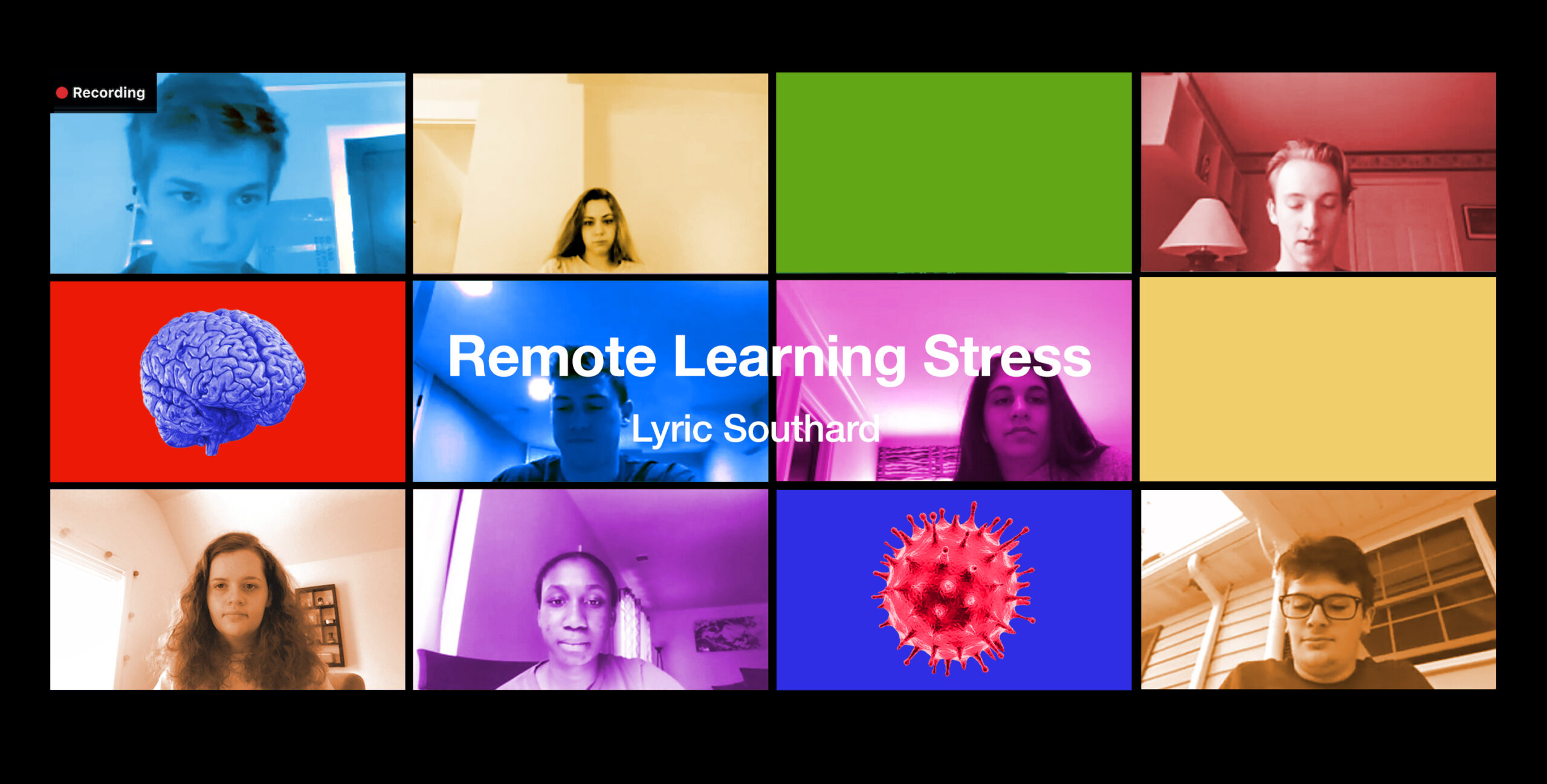
COVID-19 has affected the United States in various ways, but one of the largest impacts has been on schooling and education. As students have been unable to attend school completely in person, schools have alternatively utilized remote learning in order to continue education from home. Remote learning boasts a variety of benefits including a flexible schedule, a comfortable learning environment, and the opportunity for students to improve their technical skills.
But how easy has remote learning been for students?
Students have reported many issues with remote learning, such as decreased interest in learning, decreased interactions with peers, and more. It is exceedingly clear that one of the most detrimental impacts of remote learning is students’ increased stress.
Heather, a junior in high school, states, “Remote learning is extremely stressful. Sometimes I feel like I’m not keeping up with my work, and I always feel pressured because I’m less motivated. Also, it’s harder to learn online for me because I’m always staring at a computer or sitting at a desk all day.”
Another junior, Jennifer, recounts, “It is pretty stressful because I have been assigned way more homework and classwork than what I would usually get. Not to mention we have to stare at a screen all day. My head starts to hurt.”
Remote learning has affected every student in the country. As a result, experts fear that there will be an increase in anxiety, depression, or learning difficulties in students. It is essential for students to learn, have a full meal, and interact with their peers in school. School is not only one of the key places for students to gain social support, but it also promotes individual growth. It is here that students learn to connect with people and build relationships. After schools closed, children lacked in-person interactions with peers, a side-effect which will lead children to feel lonelier and struggle with social interactions.
“It’s honestly really depressing.” Michael, a sixteen-year-old high school student, states. “Staring at screens for hours on end for basically seven days a week because of the homework workload. It’s not the workload that’s depressing, it’s the fact that we don’t actually see one another.”
It has been reported that students’ stress levels have risen due to home-based distractions and school deadlines. Jennifer Katzenstein, the director of psychology and neurophysiology at the Hopkins All Children’s Hospital, made several observations among children of all ages that are engaged in remote learning. She explained that students (specifically college students) have difficulties adjusting to a new learning environment due to numerous distractions. These students struggle to build organizational skills and to either stay on top of their classes or maintain their grades.
“I can’t concentrate [any]more because I have a lot of distractions,” a sixteen-year-old student named James states. “I know a lot of people don’t have quiet households and that creates hardships in concentrating.”
Student motivation to work hard in school has also decreased. The North Texas Daily conducted an experiment with a series of polls given to 685 respondents. 84% of the respondents feel less motivated, 10.7% feel the same level of motivation, and 5.4% feel more motivated. Rather than feeling motivated to do work and learn, students have begun to focus more on passing their classes instead of actually learning their material.
Leila, another high school junior, says, “With remote learning, I am just doing assignments not really grasping the information. In person it kind of reinforces me to actually learn.”
Jade also says, “When we were doing school in person it was a lot easier to communicate with your teachers and I feel like I actually could digest the materials and now that we’re online it’s like we’re only learning a portion of what we’re supposed to be learning. When we’re doing things online, we’re just trying to pass the class, we’re just trying to get through the year. But when we were in person we actually needed to learn because we needed these materials for the exams and stuff but now it’s a lot easier to just get information online. When we were in school, we couldn’t do that, we had to digest and actually learn the material.”
This lack of motivation leads to higher rates of depression and anxiety. Data collected from China’s Hubei province showed that 22.6% of students had demonstrated symptoms of depression and 18.9% had shown symptoms of anxiety one month after lockdown.
A study conducted by Kori Fay, Lizzie Bannister, Eric Lanton, and Smith Dicken at theUniversity of Colorado Boulder determined the effects of remote learning on students. They asked 69 respondents various questions relating to online learning: 83.6% of the respondents strongly agreed that COVID-19 has impacted their learning environment, 58.2% strongly agreedthat the COVID-19 pandemic negatively impacted their learning environment, 43.3% strongly disagreed with doing better in school since they’ve switched to remote learning, 85.5% strongly agreed or agreed that they find it harder to focus on school now that it is online, and 76.8% strongly agreed that it is harder to do homework since the COVID-19 pandemic began.
“During in-person learning, I always paid attention and I asked questions if I needed help.” Heather states. “Overall, I really enjoyed school because I loved interacting with my classmates and teachers. Now, I’ve become lazier and sometimes I show up to class while I’m in bed. I don’t have a set routine anymore and I feel less motivated to do my best, even though I’m in the most [important?] year of high school. Lastly, it’s easier to distract myself with things like video games or Netflix, when I should actually be focusing on school.”
Students have created a few ways by which schools can reduce the stress of remote learning.
Leila suggests, “First, there should be a few minutes break between periods because it allows students to stretch and rest their eyes from the screen. I’ve been getting back pain and headaches more often due to remote learning. Second, the teachers shouldn’t be too strict on deadlines. I have some teachers who wouldn’t accept late work, and sometimes students do have a reasonable excuse. Third, I feel like there should not be standardized testing such as regents and college exams because of the ongoing pandemic. Many students are struggling to keep up and this would just add more pressure.”
Jennifer also adds, “Decrease the workload, especially in the social studies department. I find they don’t understand the limits of their students. A lot of teachers seem to think that we have more than an hour to spend on each of their assignments even though we have lives to live outside of school.”
However, the stress of remote learning is not limited to students. Teachers and schools are adjusting to new methods of teaching as well and it is important to acknowledge the fact that they are doing everything they can to help teach students efficiently and effectively. In the end, remote learning has impacted everyone involved and it’s important that we work together to make remote learning easier and more efficient for students and teachers.
To protect their identities, the names of the mentioned students have been changed.
Sources:
https://oedb.org/ilibrarian/10-advantages-to-taking-online-classes/
https://www.jhunewsletter.com/article/2020/04/how-online-learning-can-affect-student-health
https://www.ntdaily.com/students-report-less-motivation-higher-stress-levels-with-the-transition-to-online-learning/
https://www.colorado.edu/artssciences-advising/2020/05/01/how-remote-learning-has-affected-students-learning-environment-and-motivation-levels
https://www.vox.com/21429008/kids-covid-19-schools-students-remote-stress
Other Pages

Interview with Dr. Alexandre SkibaProject type

The Return Of The HistoryProject type

A Dead DreamerProject type

NothingProject type

ObsessionProject type

A Person & Their TribeProject type

Education From a DistanceProject type

Coffee, Twitter, and RevolutionProject type

When I Turned SeventeenProject type

A Winter of IsolationProject type

SpeechProject type

Desolation's PerseveranceProject type

CoraProject type

Hospital CookiesProject type

A Fragmentation of WordsProject type

The Stress of Remote LearningProject type

Sweet SixteenProject type

WordsProject type

A Christmas CarrollProject type

New York City 2020Project type

Qualified Immunity: Broken DownProject type

What Science Tells Us About Gender?Project type

Beyond The Bathroom StallsProject type

1 am thoughts on Trutharticle

Brooklyn, NY During COVID-19Photo Gallery

AboutAbout Page

Submission InformationProject type






